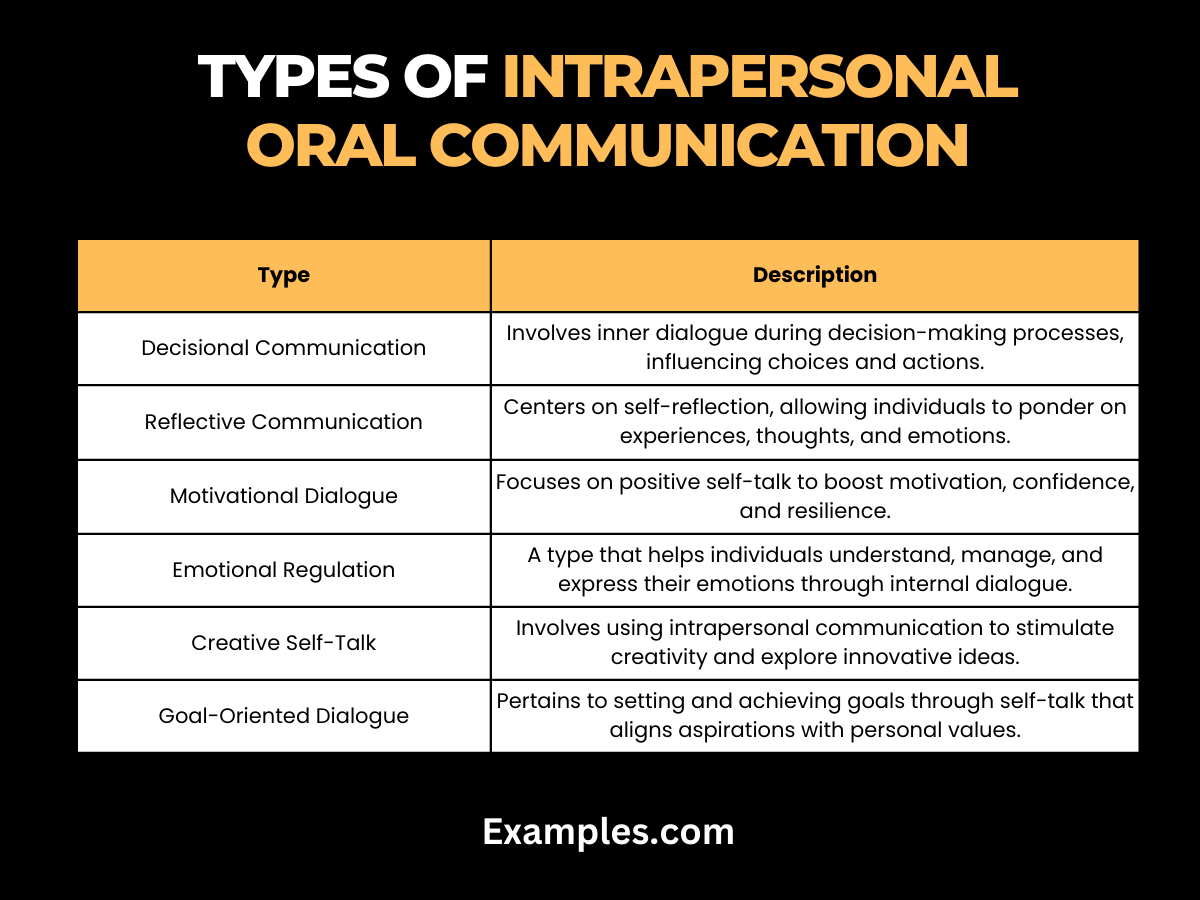19+ Intrapersonal Oral Communication Examples
Intrapersonal oral communication, a crucial facet of self-expression and reflection, delves into the art of internal dialogue. This communication style involves an individual’s self-talk, shaping thoughts and emotions. Embracing oral communication within oneself enhances clarity and self-awareness, contributing to improved interpersonal connections. Dive into the realm of effective self-expression and elevate your communication skills with this insightful guide.
What is Intrapersonal Oral Communication? – Definition

Intrapersonal oral communication refers to the internal dialogue we have with ourselves. It involves the constant exchange of thoughts, feelings, and ideas within our own mind. Oral communication within oneself is a dynamic process, shaping our perspectives and influencing how we interact with the world.
What is the Best Example of Intrapersonal Oral Communication?

A prime example of intrapersonal oral communication is the inner conversation we engage in while making decisions. It’s the self-reflection before responding to external stimuli, impacting our actions and choices. Understanding this facet enhances our self-awareness and interpersonal relationships.
20 Intrapersonal Oral Communication Examples
Unlock the power of self-expression with Intrapersonal Oral Communication. This dynamic process involves an internal exchange of thoughts, feelings, and ideas, shaping your perspectives and influencing interactions with the world. Explore the intricacies of self-dialogue for enhanced self-awareness and interpersonal relationships.
- Decision-Making: Embrace intrapersonal communication in decision-making, where the inner dialogue guides actions and choices.
- Goal Setting: Utilize self-talk to set and achieve goals, fostering motivation and clarity in your aspirations.
- Stress Management: Navigate stress through positive self-talk, promoting resilience and well-being.
- Problem Solving: Engage in intrapersonal communication to analyze problems and devise effective solutions.
- Emotional Regulation: Use self-dialogue to understand and regulate emotions, promoting emotional intelligence.
- Self-Motivation: Foster self-motivation through positive affirmations and empowering self-talk.
- Personal Reflection: Enhance self-awareness through reflective intrapersonal communication, gaining insights into personal growth.
- Creativity Boost: Stimulate creativity by engaging in a constructive inner dialogue, exploring innovative ideas.
- Confidence Building: Develop confidence through encouraging self-talk, overcoming self-doubt and insecurities.
- Mindfulness Practice: Embrace intrapersonal communication in mindfulness, connecting with the present moment.
- Learning Enhancement: Optimize learning experiences by using self-talk to reinforce and consolidate new information.
- Overcoming Challenges: Face challenges with resilience, employing positive intrapersonal communication for motivation.
- Time Management: Organize tasks efficiently by strategizing through effective self-dialogue.
- Decision Reflection: After making decisions, reflect on the intrapersonal communication process, learning and adapting.
- Personal Values: Align actions with personal values through introspective intrapersonal communication.
- Building Resilience: Strengthen resilience by cultivating a positive inner dialogue during adversity.
- Coping Strategies: Develop effective coping strategies by leveraging intrapersonal communication during tough times.
- Identity Exploration: Explore personal identity through introspective self-talk, understanding one’s beliefs and values.
- Achieving Balance: Strike a balance in life by using intrapersonal communication to prioritize and manage responsibilities.
- Positive Self-Image: Foster a positive self-image through affirming intrapersonal communication, boosting self-esteem.
Types of Intrapersonal Oral Communication

| Type | Description |
|---|---|
| Decisional Communication | Involves inner dialogue during decision-making processes, influencing choices and actions. |
| Reflective Communication | Centers on self-reflection, allowing individuals to ponder on experiences, thoughts, and emotions. |
| Motivational Dialogue | Focuses on positive self-talk to boost motivation, confidence, and resilience. |
| Emotional Regulation | A type that helps individuals understand, manage, and express their emotions through internal dialogue. |
| Creative Self-Talk | Involves using intrapersonal communication to stimulate creativity and explore innovative ideas. |
| Goal-Oriented Dialogue | Pertains to setting and achieving goals through self-talk that aligns aspirations with personal values. |
What are Features of Intrapersonal Oral Communication?
Intrapersonal oral communication is a multifaceted process with distinct features that shape the way individuals engage in self-dialogue. Understanding these features is crucial for harnessing the full potential of intrapersonal communication.
- Self-Reflection: Intrapersonal oral communication involves a continuous process of self-reflection, allowing individuals to analyze their thoughts and emotions.
- Decision-Making Influence: It significantly impacts decision-making by guiding individuals through an inner dialogue that weighs options and considers consequences.
- Emotional Regulation: This form of communication aids in understanding and regulating emotions, fostering emotional intelligence and resilience.
- Motivational Power: Intrapersonal communication serves as a powerful motivational tool, where positive self-talk can boost confidence and drive.
- Clarity of Thought: It contributes to the clarity of thought by providing a platform for organizing ideas, setting goals, and establishing priorities.
- Creativity Enhancement: Engaging in intrapersonal dialogue stimulates creativity, encouraging individuals to explore innovative ideas and solutions.
- Personal Growth: The process is integral to personal growth, facilitating introspection and continuous learning.
- Stress Management: Utilizing intrapersonal communication techniques can be effective in managing stress, promoting a balanced mental state.
- Goal Setting and Achievement: It aids in setting and achieving goals by aligning aspirations with individual values through self-talk.
- Identity Development: Intrapersonal oral communication plays a role in identity development, helping individuals define and understand their beliefs and values.
To the insightful exploration of intrapersonal oral communication, it’s evident that this form of communication serves as a foundational tool for personal growth and emotional intelligence. By engaging in internal dialogues, individuals gain clarity in decision-making, enhance emotional regulation, and foster creativity. It’s a continuous journey of self-reflection and self-awareness, where one learns to align personal values with actions and goals.
Moreover, the academic perspective on intrapersonal communication provides further insights into its impact and applications. Scholars and students can access in-depth research and articles, such as those available on Academic Oxford University Press, to explore various dimensions of this communication form. These resources delve into the complexities of intrapersonal communication, offering a more scholarly and detailed understanding of how it shapes our thoughts, emotions, and overall well-being.



